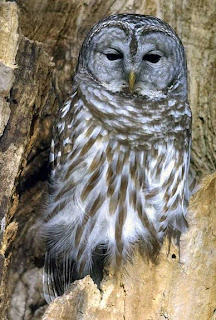Trends in bird colonizers:
(ECOLOGICAL RELEASE)
1) Density compensation--colonizers reach huge numbers without competitors and territories shrink,
2) Increased sexual dimorphism--due to lack of predators colonizers are more able to use resources.
For eample, in the Huia on New Zealand (extinct), the male was straight-billed whereas the female had greatly curved-bill.
3) Longer bills than mainland relatives--bigger prey can be taken now, as well as small stuff.
4) More generalized habitat preferences. Ricklefs and Cox found that the smaller the island, the more generalized the species.
5. There is a trend towards flightlessness. Island birds are also often smaller than mainland populations. All mainland rails fly but many island forms don't. Rhapidae: Dodos. 50 lb. pigeon. All this has to do with lack of mammals and reptiles (only bats, among mammals, are good colonizers).
6. Differentiation--island forms seldom resemble mainland populations. Often you can't tell who they came from because of totally new selective regimes.
7. Adaptive radiation--One island can't produce many new species but this is not so in archipelagos (but can occur on mainland too). Drepanidae (Hawiian Honeycreepers): 28 species from original colonizer now show an incredible diversity of bill shapes. It has been said that if Darwin had visited Hawaii instead of the Galapagos, he would not have come up with his theory of evolution since he would not have deduced the interrelatedness of the birds.
1) Density compensation--colonizers reach huge numbers without competitors and territories shrink,
2) Increased sexual dimorphism--due to lack of predators colonizers are more able to use resources.
For eample, in the Huia on New Zealand (extinct), the male was straight-billed whereas the female had greatly curved-bill.
3) Longer bills than mainland relatives--bigger prey can be taken now, as well as small stuff.
4) More generalized habitat preferences. Ricklefs and Cox found that the smaller the island, the more generalized the species.
| location | number of species | number of habitats occupied/species |
| Panama | 135 | 2.01 |
| Trinidad | 108 | 2.35 |
| Jamaica | 56 | 3.43 |
| Sta. Lucia | 33 | 4.15 |
5. There is a trend towards flightlessness. Island birds are also often smaller than mainland populations. All mainland rails fly but many island forms don't. Rhapidae: Dodos. 50 lb. pigeon. All this has to do with lack of mammals and reptiles (only bats, among mammals, are good colonizers).
6. Differentiation--island forms seldom resemble mainland populations. Often you can't tell who they came from because of totally new selective regimes.
7. Adaptive radiation--One island can't produce many new species but this is not so in archipelagos (but can occur on mainland too). Drepanidae (Hawiian Honeycreepers): 28 species from original colonizer now show an incredible diversity of bill shapes. It has been said that if Darwin had visited Hawaii instead of the Galapagos, he would not have come up with his theory of evolution since he would not have deduced the interrelatedness of the birds.
Northern Pintail




Comments
Post a Comment